Role of the South Asian High in the Onset Process of the Asian Summer Monsoon during Spring-to-Summer Transition
Abstract
:1. Introduction
2. Data and Methods
3. Results
3.1. Evolution of SAH and its Relation with ASM Onset Process
3.2. Key Factor Influencing the SAH Evolution
3.3. Physical Process for the Mutual Promotion between the SAH and ASM Rainfall
4. Conclusions
Author Contributions
Funding
Acknowledgments
Conflicts of Interest
References
- Mason, R.B.; Anderson, C.E. The Development and Decay of the 100mb Summertime Anticyclone over Southern Asia. Mon. Weather Rev. 1963, 91, 3–12. [Google Scholar] [CrossRef]
- Tao, S.; Zhu, F. The 100-mb flow patterns in Southern Asia in summer and its relation to the advance and retreat of the West-Pacific subtropical anticyclone over the Far East. Acta Meteorol. Sin. 1964, 34, 385–396. [Google Scholar]
- Krishnamurti, T.N.; Bhalme, H. Oscillations of a monsoon system. Part I. Observational aspects. J. Atmos. Sci. 1976, 33, 1937–1954. [Google Scholar] [CrossRef]
- Tao, S.; Chen, L. A Review of Recent Research on the East Asian Summer Monsoon in China. In Monsoon Meteorology; Chang, C.-P., Krishnamurti, T.N., Eds.; Oxford University Press: Oxford, UK, 1987; pp. 60–92. [Google Scholar]
- Wei, W.; Zhang, R.; Wen, M. Meridional variation of South Asian High and its relationship with the summer precipitation over China. J. Appl. Meteorol. Sci. 2012, 23, 650–659. [Google Scholar]
- Wei, W.; Zhang, R.; Wen, M.; Rong, X.; Li, T. Impact of Indian summer monsoon on the South Asian High and its influence on summer rainfall over China. Clim. Dyn. 2014, 43, 1257–1269. [Google Scholar] [CrossRef]
- Wei, W.; Zhang, R.; Wen, M.; Kim, B.-J.; Nam, J.-C. Interannual Variation of the South Asian High and Its Relation with Indian and East Asian Summer Monsoon Rainfall. J. Clim. 2015, 28, 2623–2634. [Google Scholar] [CrossRef]
- Wei, W.; Zhang, R.; Wen, M.; Yang, S. Relationship between the Asian Westerly Jet Stream and Summer Rainfall over Central Asia and North China: Roles of the Indian Monsoon and the South Asian High. J. Clim. 2017, 30, 537–552. [Google Scholar] [CrossRef]
- Xue, X.; Chen, W.; Chen, S.; Zhou, D. Modulation of the connection between boreal winter ENSO and the South Asian high in the following summer by the stratospheric quasi-biennial oscillation. J. Geophys. Res. Atmos. 2015, 120, 7393–7411. [Google Scholar] [CrossRef]
- Noska, R.; Misra, V. Characterizing the onset and demise of the Indian summer monsoon. Geophys. Res. Lett. 2016, 43, 4547–4554. [Google Scholar] [CrossRef]
- Shi, J.; Qian, W. Connection between Anomalous Zonal Activities of the South Asian High and Eurasian Summer Climate Anomalies. J. Clim. 2016, 29, 8249–8267. [Google Scholar] [CrossRef]
- Zhang, P.; Liu, Y.; Lu, J. Impact of East Asian Summer Monsoon on the Interannual Variation of South Asian High. J. Clim. 2016, 29, 159–173. [Google Scholar] [CrossRef]
- Liu, Y.; Wang, Z.; Zhuo, H.; Wu, G. Two types of summertime heating over Asian large-scale orography and excitation of potential-vorticity forcing II. Sensible heating over Tibetan-Iranian Plateau. Sci. China Earth Sci. 2017, 60, 733–744. [Google Scholar] [CrossRef]
- Wang, L.; Dai, A.; Guo, S.; Ge, J. Establishment of the South Asian high over the Indo-China Peninsula during late spring to summer. Adv. Atmos. Sci. 2017, 34, 169–180. [Google Scholar] [CrossRef]
- Xue, X.; Chen, W.; Chen, S.F. The climatology and interannual variability of the South Asia high and its relationship with ENSO in CMIP5 models. Clim. Dyn. 2017, 48, 3507–3528. [Google Scholar] [CrossRef]
- Xue, X.; Chen, W.; Chen, S.; Feng, J. PDO modulation of the ENSO impact on the summer South Asian high. Clim. Dyn. 2018, 50, 1393–1411. [Google Scholar] [CrossRef]
- Li, H.; He, S.; Fan, K.; Wang, H. Relationship between the onset date of the Meiyu and the South Asian anticyclone in April and the related mechanisms. Clim. Dyn. 2019, 52, 209–226. [Google Scholar] [CrossRef]
- Krishnamurti, T. Summer monsoon experiment—A review. Mon. Weather Rev. 1985, 113, 1590–1626. [Google Scholar] [CrossRef]
- Krishnamurti, T. Tropical east-west circulations during the northern summer. J. Atmos. Sci. 1971, 28, 1342–1347. [Google Scholar] [CrossRef]
- Krishnamurti, T. Observational study of the tropical upper tropospheric motion field during the Northern Hemisphere summer. J. Appl. Meteorol. 1971, 10, 1066–1096. [Google Scholar] [CrossRef]
- Bansod, S.D.; Yin, Z.Y.; Lin, Z.; Zhang, X. Thermal field over Tibetan Plateau and Indian summer monsoon rainfall. Int. J. Climatol. 2003, 23, 1589–1605. [Google Scholar] [CrossRef]
- Ashfaq, M.; Shi, Y.; Tung, W.; Trapp, R.J.; Gao, X.; Pal, J.S.; Diffenbaugh, N.S. Suppression of south Asian summer monsoon precipitation in the 21st century. Geophys. Res. Lett. 2009, 36. [Google Scholar] [CrossRef]
- Yanai, M.; Wu, G.X. Effects of the Tibetan Plateau. In The Asian Monsoon; Springer Praxis Books; Springer: Berlin/Heidelberg, Germany, 2006; pp. 513–549. [Google Scholar]
- Koteswaram, P. The Easterly Jet Stream in the Tropics. Tellus 1958, 10, 43–57. [Google Scholar] [CrossRef]
- Ren, X.; Yang, D.; Yang, X.-Q. Characteristics and Mechanisms of the Subseasonal Eastward Extension of the South Asian High. J. Clim. 2015, 28, 6799–6822. [Google Scholar] [CrossRef]
- Chen, Y.; Zhai, P. Mechanisms for concurrent low-latitude circulation anomalies responsible for persistent extreme precipitation in the Yangtze River Valley. Clim. Dyn. 2016, 47, 989–1006. [Google Scholar] [CrossRef]
- Guan, W.; Ren, X.; Shang, W.; Hu, H. Subseasonal Zonal Oscillation of the Western Pacific Subtropical High during Early Summer. J. Meteorol. Res. 2018, 32, 768–780. [Google Scholar] [CrossRef]
- Krishnamurti, T.N.; Daggupaty, S.M.; Fein, J.; Kanamitsu, M.; Lee, J.D. Tibetan high and upper tropospheric tropical circulation during northern summer. Bull. Am. Meteorol. Soc. 1973, 54, 1234–1249. [Google Scholar] [CrossRef]
- Yang, H.; Sun, S. Longitudinal displacement of the subtropical high in the western Pacific in summer and its influence. Adv. Atmos. Sci. 2003, 20, 921–933. [Google Scholar]
- Ren, R.; Wu, G. On the short-term structure and formation of the subtropical anticyclone in the summer of 1998. Acta Meteorol. Sin. 2003, 61, 180–195. [Google Scholar]
- Wu, G.; Duan, A.; Liu, Y.; Mao, J.; Ren, R.; Bao, Q.; He, B.; Liu, B.; Hu, W. Tibetan Plateau climate dynamics: Recent research progress and outlook. Natl. Sci. Rev. 2015, 2, 100–116. [Google Scholar] [CrossRef]
- Wu, R.; Wang, B. Multi-stage onset of the summer monsoon over the western North Pacific. Clim. Dyn. 2001, 17, 277–289. [Google Scholar] [CrossRef]
- Wang, B. The Time-Space Structure of the Asian-Pacific Summer Monsoon: A Fast Annual Cycle View. J. Clim. 2002, 15, 2001–2019. [Google Scholar] [CrossRef]
- Wu, R. Subseasonal variability during the South China Sea summer monsoon onset. Clim. Dyn. 2009, 34, 629–642. [Google Scholar] [CrossRef]
- Liu, B.; He, J.; Wang, L. Characteristics of the South Asia high establishment processes above t he Indo2China Peninsula from April to May and t heir possible mechanism. Chin. J. Atmos. Sci. 2009, 33, 1319–1332. [Google Scholar]
- Liu, B.; Wu, G.; Mao, J.; He, J. Genesis of the South Asian High and Its Impact on the Asian Summer Monsoon Onset. J. Clim. 2013, 26, 2976–2991. [Google Scholar] [CrossRef]
- Wu, G.; Ren, S.; Xu, J.; Wang, D.; Bao, Q.; Liu, B.; Liu, Y. Impact of tropical cyclone development on the instability of South Asian High and the summer monsoon onset over Bay of Bengal. Clim. Dyn. 2013, 41, 2603–2616. [Google Scholar] [CrossRef]
- Liu, B.; He, J.; Wang, L. On a possible mechanism for southern Asian convection influencing the South Asian high establishment during winter to summer transition. J. Trop. Meteorol. 2012, 18, 473–484. [Google Scholar]
- He, J.; Liu, B.; Wu, G. Formation of South Asia high from late spring to early summer and its association with ENSO events. Chin. J. Atmos. Sci. 2014, 38, 670–684. [Google Scholar] [CrossRef]
- Liu, B.; Wu, G.; Ren, R. Influences of ENSO on the vertical coupling of atmospheric circulation during the onset of South Asian summer monsoon. Clim. Dyn. 2015, 45, 1859–1875. [Google Scholar] [CrossRef]
- Wang, B.; Zhang, Y.S.; Lu, M.M. Definition of South China Sea monsoon onset and commencement of the East Asia summer monsoon. J. Clim. 2004, 17, 699–710. [Google Scholar] [CrossRef]
- Zhou, W.; Chan, J.C. ENSO and the South China Sea summer monsoon onset. Int. J. Climatol. 2007, 27, 157–167. [Google Scholar] [CrossRef]
- Zhou, W.; Chan, J.C.L. Intraseasonal oscillations and the South China Sea summer monsoon onset. Int. J. Climatol. 2005, 25, 1585–1609. [Google Scholar] [CrossRef]
- Webster, P.J.; Yang, S. Monsoon and ENSO: Selectively interactive systems. Q. J. R. Meteorol. Soc. 1992, 118, 877–926. [Google Scholar] [CrossRef]
- Wang, B.; Wu, Z.; Li, J.; Liu, J.; Chang, C.-P.; Ding, Y.; Wu, G. How to Measure the Strength of the East Asian Summer Monsoon. J. Clim. 2008, 21, 4449–4463. [Google Scholar] [CrossRef]
- Yang, H.; Li, C.Y. Effect of the tropical Pacific-Indian Ocean temperature anomaly mode on the South Asia High. Chin. J. Atmos. Sci. 2005, 29, 99–110. [Google Scholar]
- Yang, J.; Liu, Q. The “charge/discharge” roles of the basin-wide mode of the Indian Ocean SST anomaly—Influence on the South Asia High in summer. Acta Oceanol. Sin. 2008, 30, 12–19. [Google Scholar]
- Zhou, T.J.; Yu, R.C.; Zhang, J.; Drange, H.; Cassou, C.; Deser, C.; Hodson, D.L.R.; Sanchez-Gomez, E.; Li, J.; Keenlyside, N.; et al. Why the Western Pacific Subtropical High Has Extended Westward since the Late 1970s. J. Clim. 2009, 22, 2199–2215. [Google Scholar] [CrossRef]
- Huang, G.; Qu, X.; Hu, K.M. The Impact of the Tropical Indian Ocean on South Asian High in Boreal Summer. Adv. Atmos. Sci. 2011, 28, 421–432. [Google Scholar] [CrossRef]
- Kanamitsu, M.; Ebisuzaki, W.; Woollen, J.; Yang, S.K.; Hnilo, J.J.; Fiorino, M.; Potter, G.L. NCEP–DOE AMIP-II Reanalysis (R-2). Bull. Am. Meteorol. Soc. 2002, 83, 1631–1643. [Google Scholar] [CrossRef]
- Liebmann, B.; Smith, C.A. Description of a complete (interpolated) outgoing longwave radiation dataset. Bull. Am. Meteorol. Soc. 1996, 77, 1275–1277. [Google Scholar]
- Mao, J.Y.; Chan, J.C.L.; Wu, G.X. Relationship between the onset of the South China Sea summer monsoon and the structure of the Asian subtropical anticyclone. J. Meteorol. Soc. Jpn. 2004, 82, 845–859. [Google Scholar] [CrossRef]
- Li, C.; Yanai, M. The Onset and Interannual Variability of the Asian Summer Monsoon in Relation to Land-Sea Thermal Contrast. J. Clim. 1996, 9, 358–375. [Google Scholar] [CrossRef]
- Webster, P.J.; Magaña, V.O.; Palmer, T.N.; Shukla, J.; Tomas, R.A.; Yanai, M.; Yasunari, T. Monsoons: Processes, predictability, and the prospects for prediction. J. Geophys. Res. 1998, 103, 14451–14510. [Google Scholar] [CrossRef]
- Mao, J.; Wu, G. Interannual variability in the onset of the summer monsoon over the Eastern Bay of Bengal. Theor. Appl. Climatol. 2007, 89, 155–170. [Google Scholar] [CrossRef]
- Misra, V.; Bhardwaj, A.; Mishra, A. Local onset and demise of the Indian summer monsoon. Clim. Dyn. 2018, 51, 1609–1622. [Google Scholar] [CrossRef]
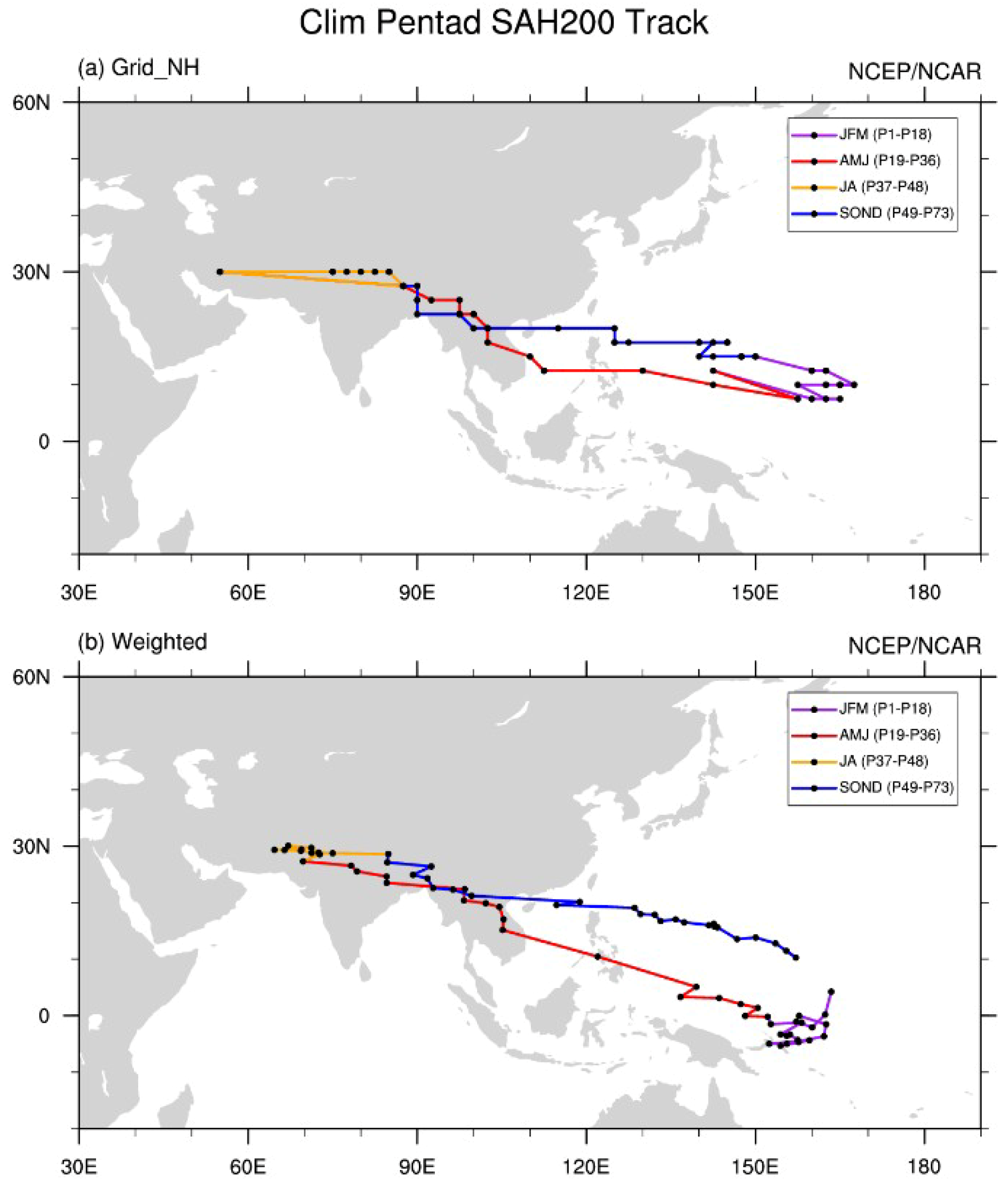
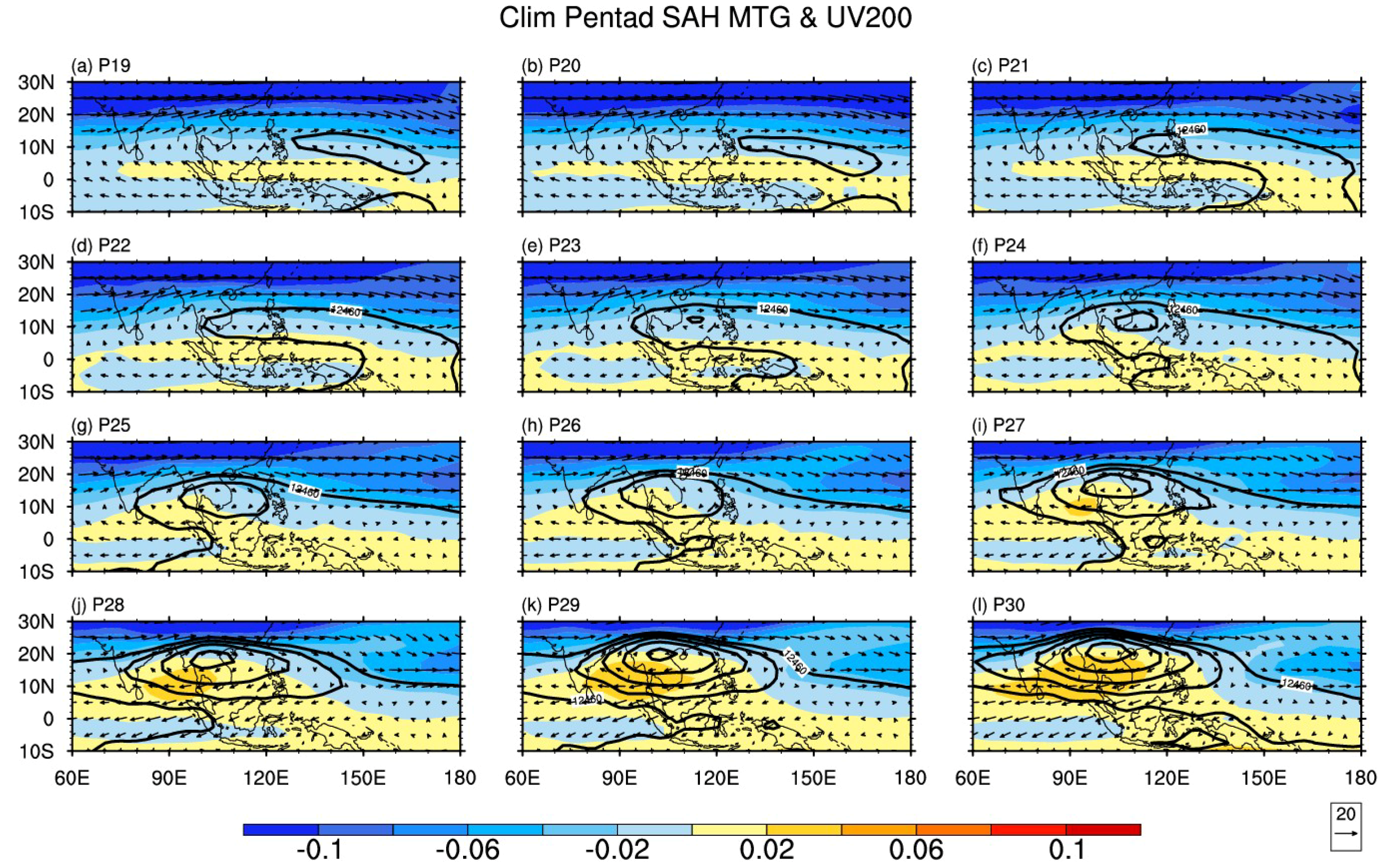
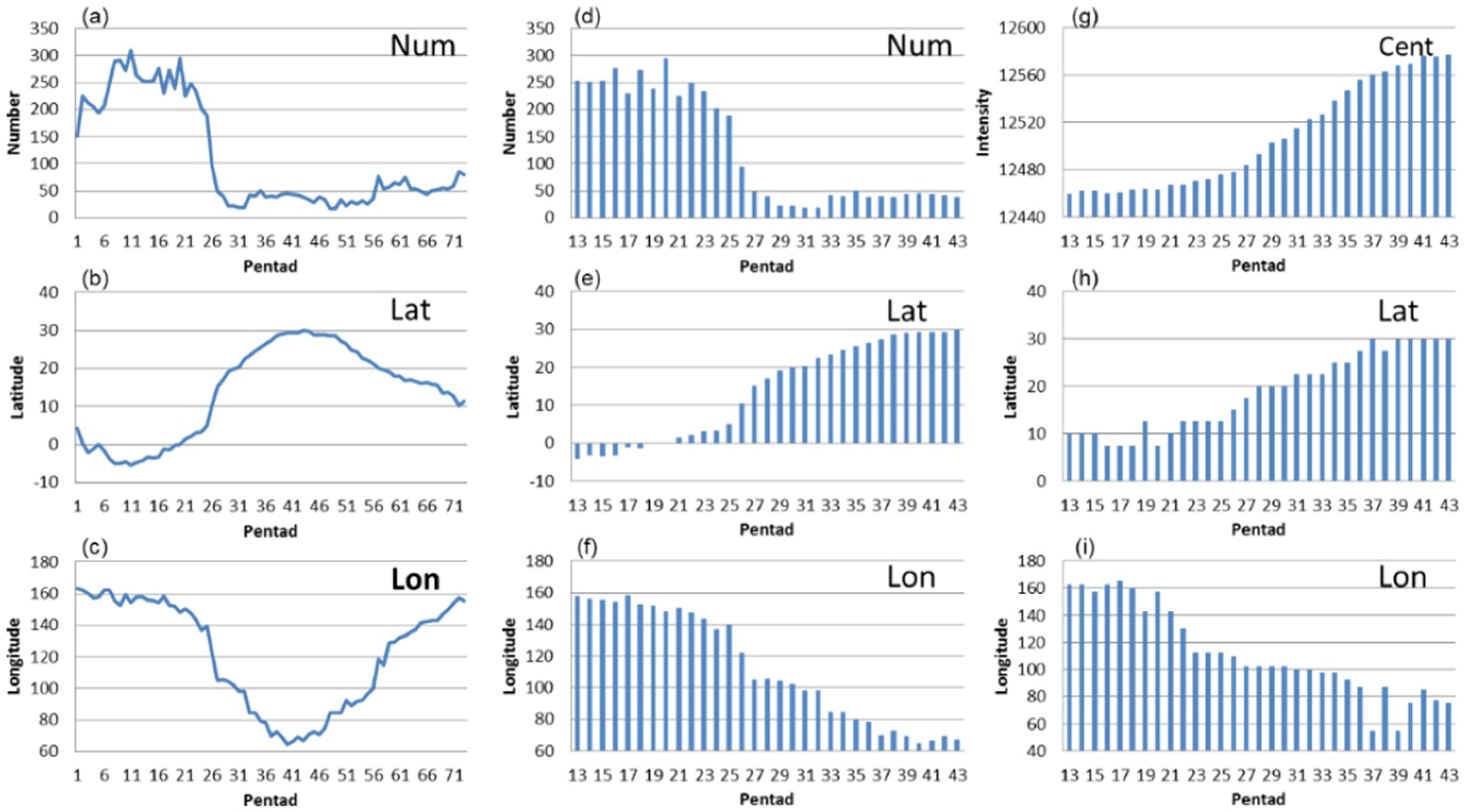
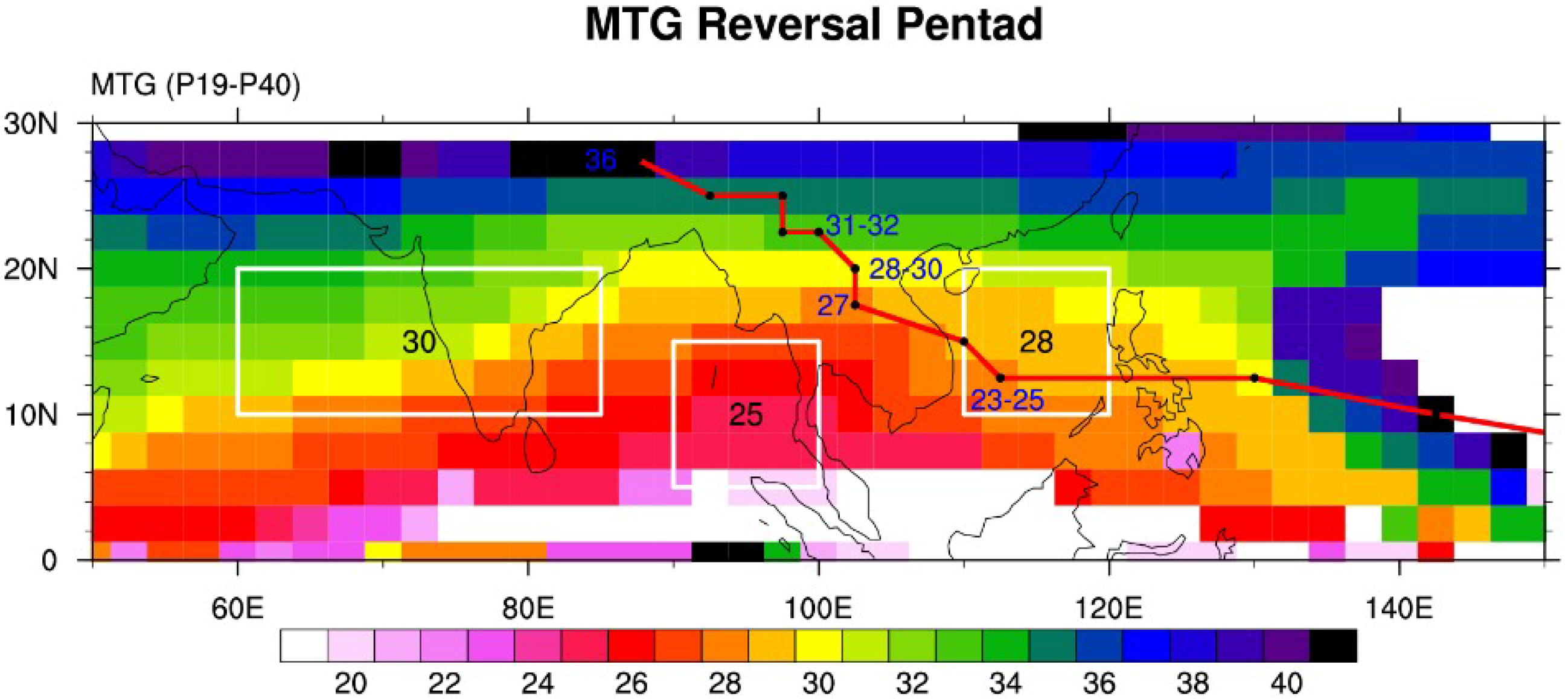
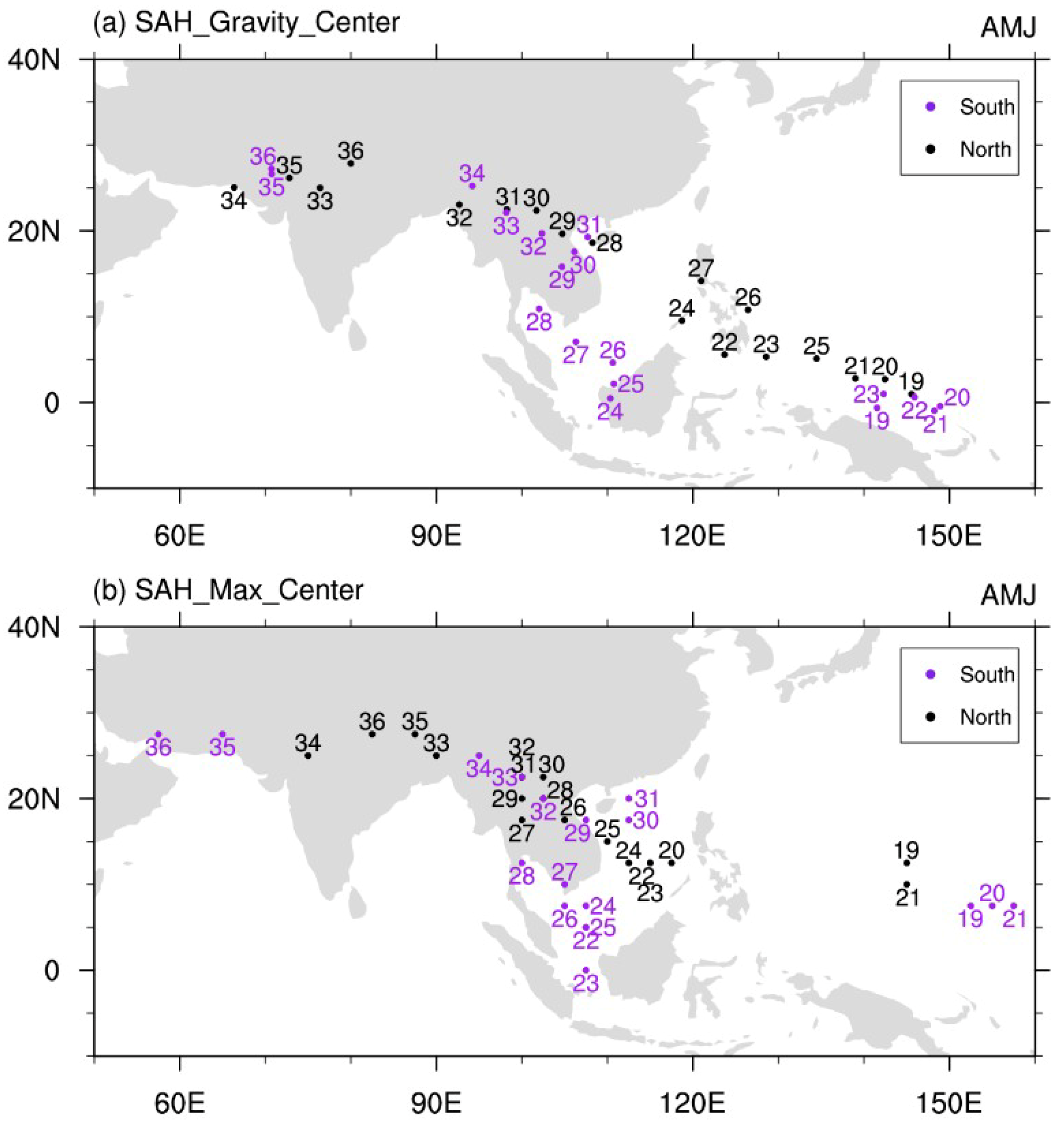

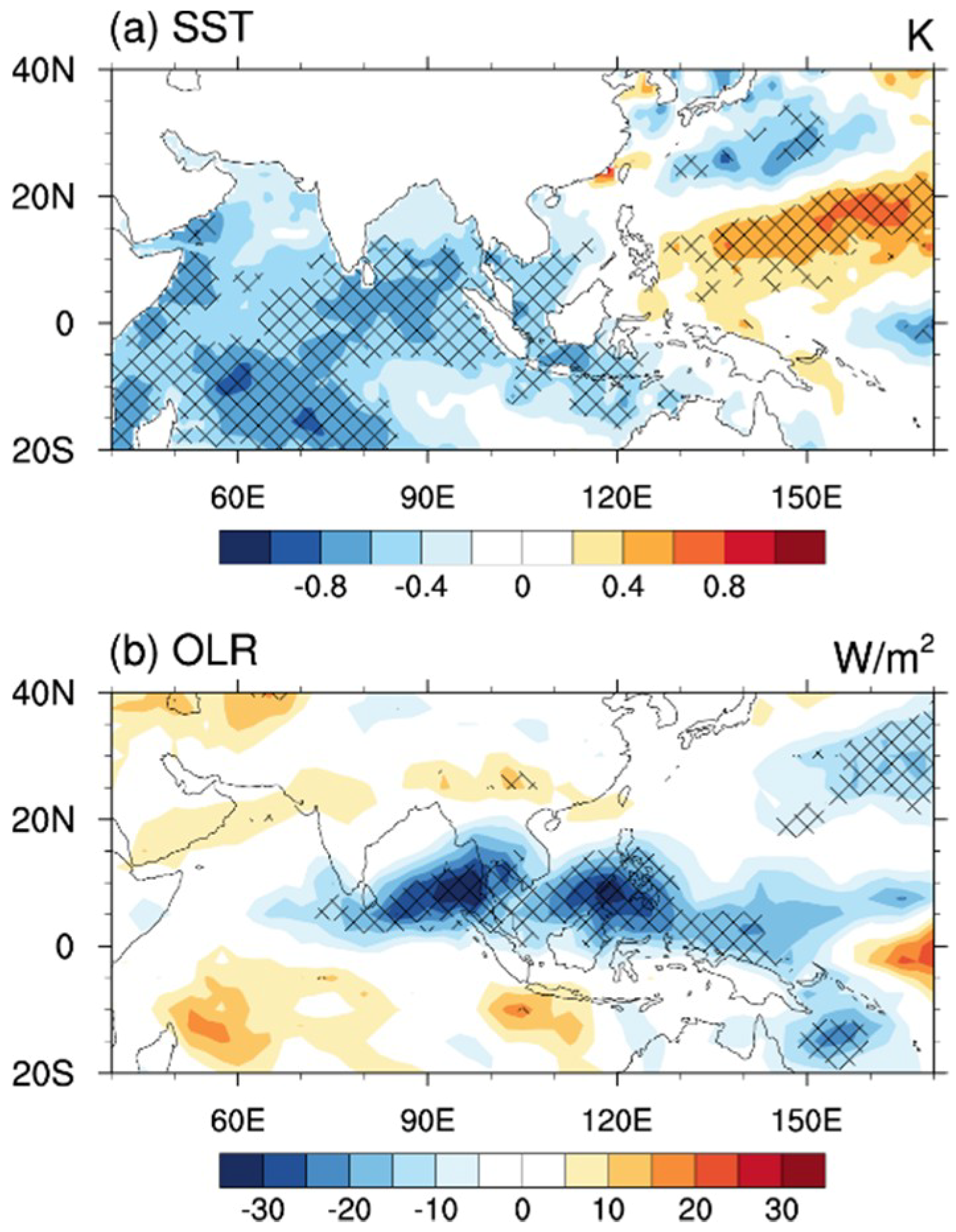
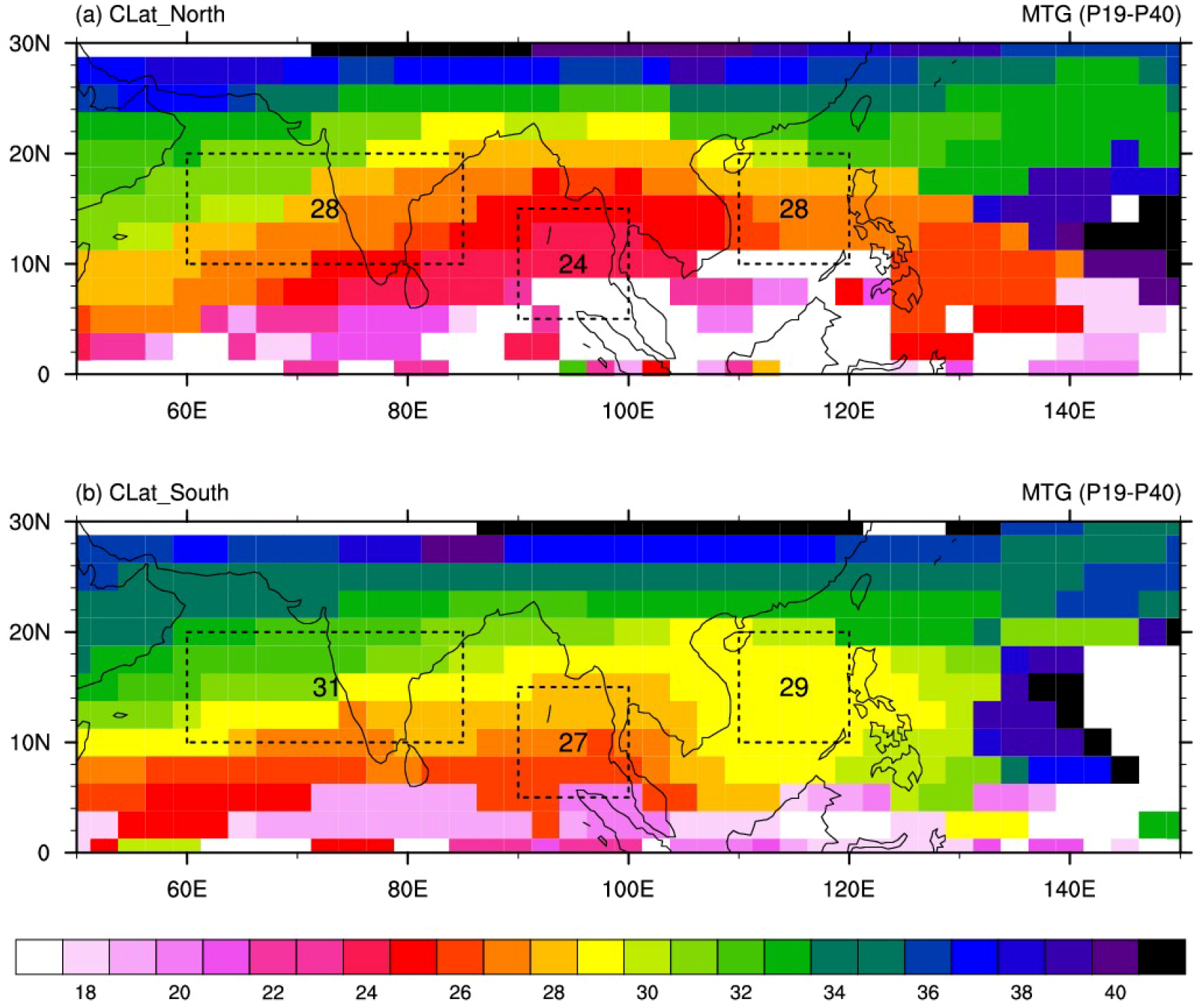
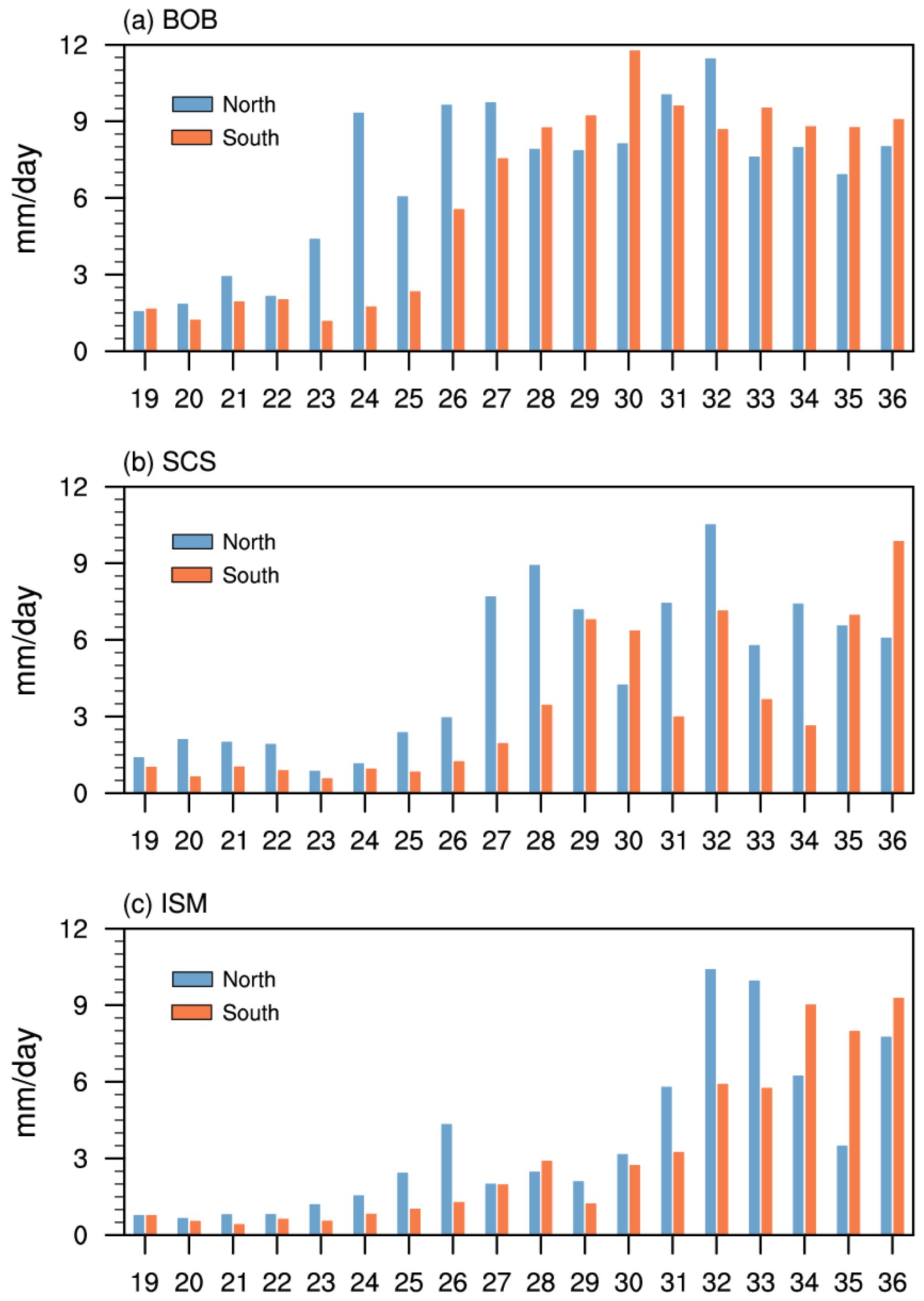
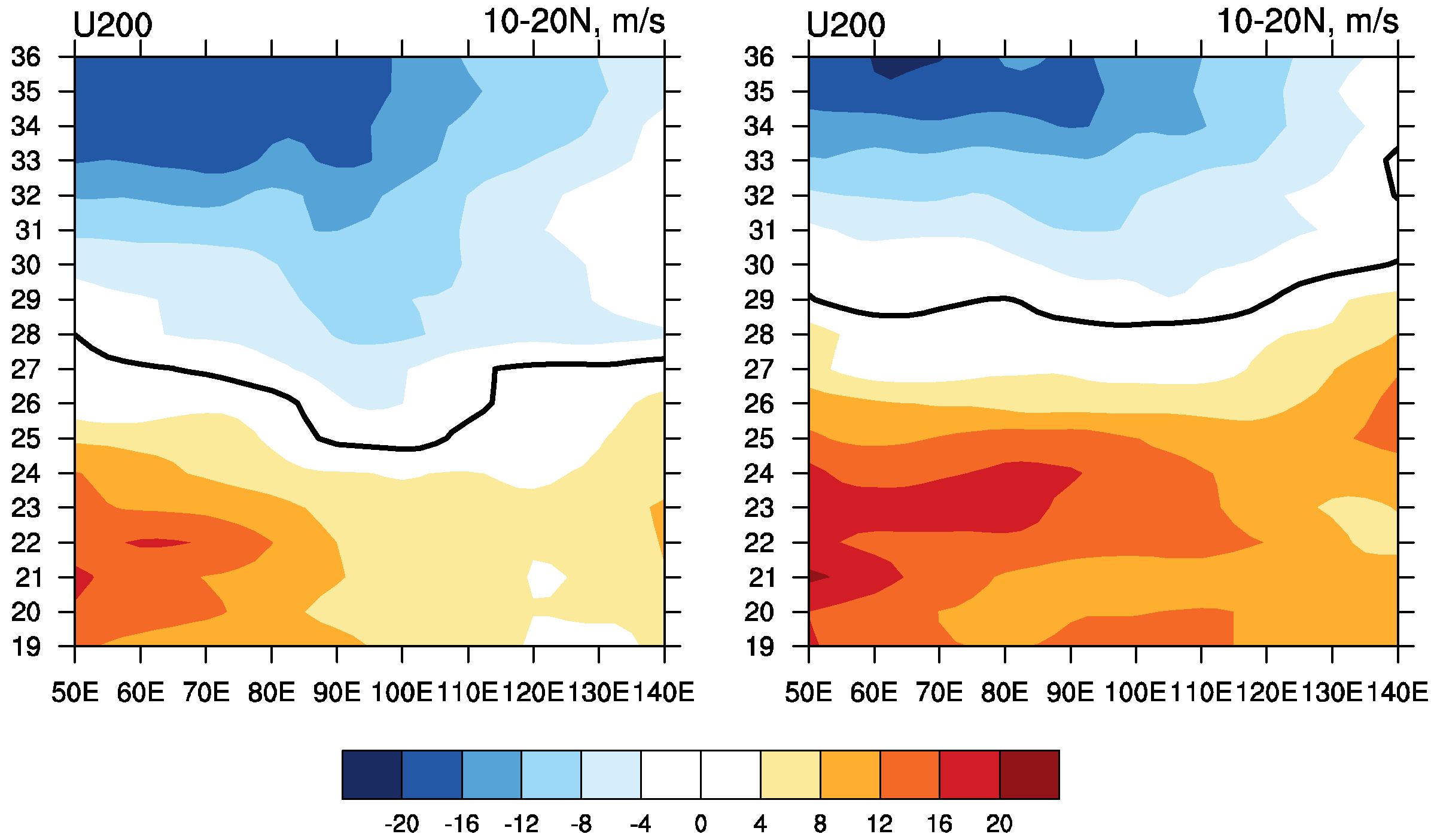
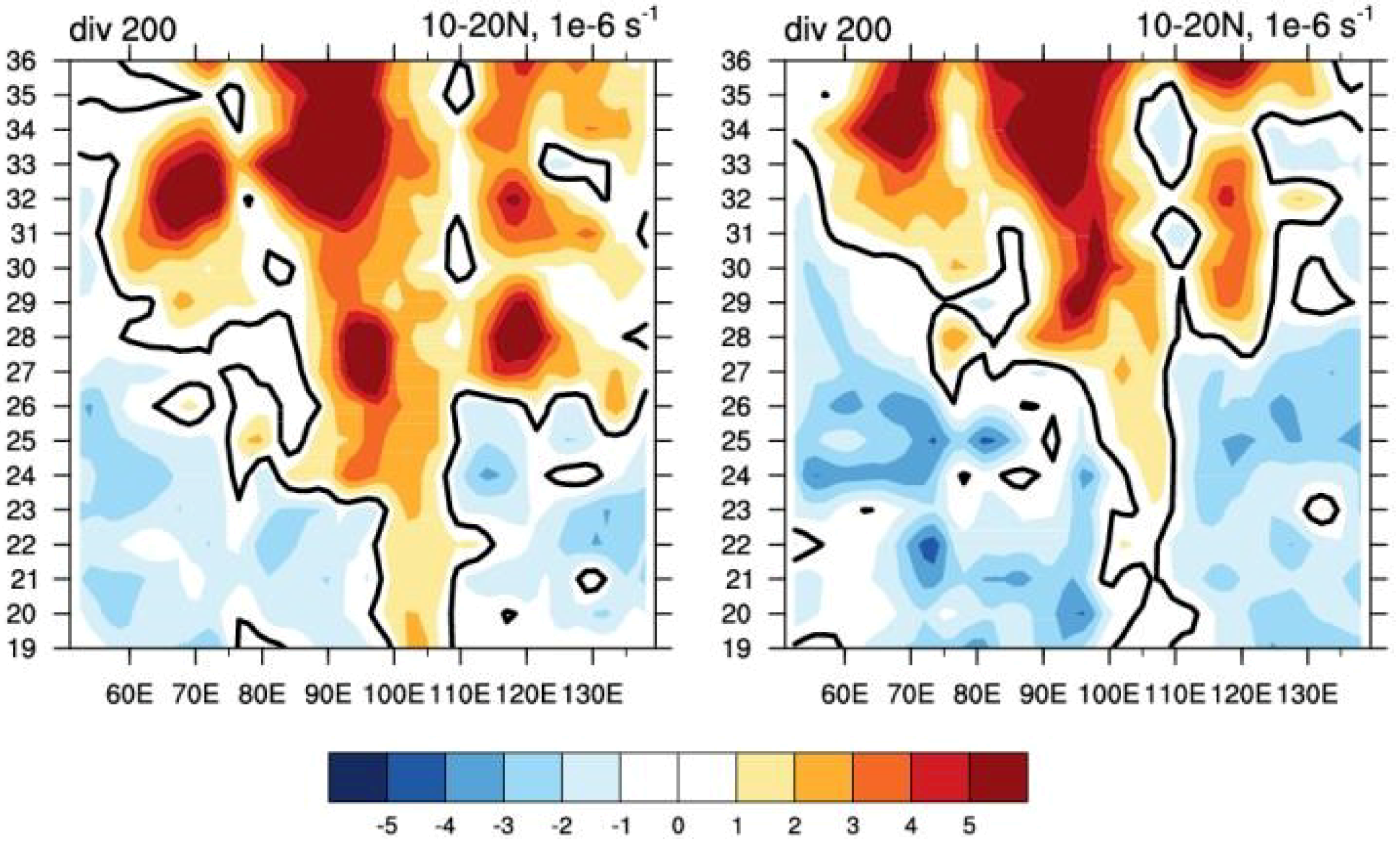
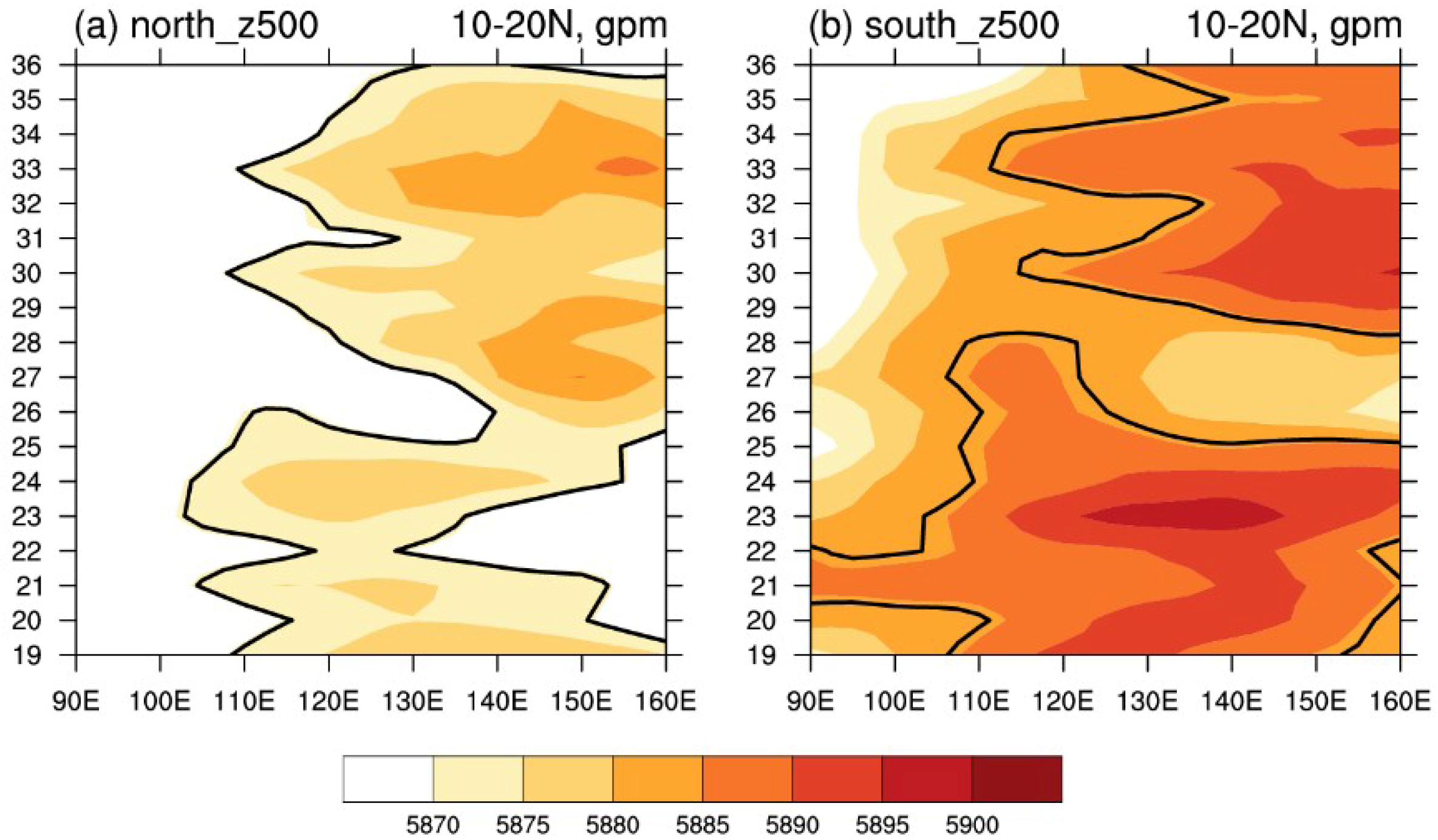
© 2019 by the authors. Licensee MDPI, Basel, Switzerland. This article is an open access article distributed under the terms and conditions of the Creative Commons Attribution (CC BY) license (http://creativecommons.org/licenses/by/4.0/).
Share and Cite
Wei, W.; Wu, Y.; Yang, S.; Zhou, W. Role of the South Asian High in the Onset Process of the Asian Summer Monsoon during Spring-to-Summer Transition. Atmosphere 2019, 10, 239. https://doi.org/10.3390/atmos10050239
Wei W, Wu Y, Yang S, Zhou W. Role of the South Asian High in the Onset Process of the Asian Summer Monsoon during Spring-to-Summer Transition. Atmosphere. 2019; 10(5):239. https://doi.org/10.3390/atmos10050239
Chicago/Turabian StyleWei, Wei, Yuting Wu, Song Yang, and Wen Zhou. 2019. "Role of the South Asian High in the Onset Process of the Asian Summer Monsoon during Spring-to-Summer Transition" Atmosphere 10, no. 5: 239. https://doi.org/10.3390/atmos10050239
APA StyleWei, W., Wu, Y., Yang, S., & Zhou, W. (2019). Role of the South Asian High in the Onset Process of the Asian Summer Monsoon during Spring-to-Summer Transition. Atmosphere, 10(5), 239. https://doi.org/10.3390/atmos10050239





